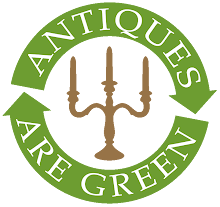 This really is 'antiques central' with at least a dozen shops along this pretty tree-lined avenue. It seems to be where real money can be spent, with many shops stocking the national speciality of lustrous ceramics by Zsolnay, based in the town of Pecs. Also worth checking out is the Hungarian version of Art Deco and post war ceramics by the potter Gesu Gorka and his daughter Livia.
This really is 'antiques central' with at least a dozen shops along this pretty tree-lined avenue. It seems to be where real money can be spent, with many shops stocking the national speciality of lustrous ceramics by Zsolnay, based in the town of Pecs. Also worth checking out is the Hungarian version of Art Deco and post war ceramics by the potter Gesu Gorka and his daughter Livia.Most of the Art Deco furniture I saw seemed to be heavy in weight and style, and large in size, meaning it had great visual impact. Furthermore, much like antiques shops in the UK and the US, it's also worth taking a closer look as some pieces are recent rather than period. However, they're identified as such and priced accordingly. As for the work of the mercurial Gorka pair, if you're a fan of avant garde ceramics or West German 'Fat Lava' ceramics, you're sure to be in heaven. Virtually unknown outside of Hungary, I think their work could be a good bet for the future. However, dealers seem to think the same as me and you can pay anything from £50 upwards for the smallest piece - more standard prices for a meaty example are anything from £150-500.
Hungry for lunch after so much browsing, I stopped at the rather fine Café Picard, one of the many restaurants that can be found dotted between the antiques emporia. While the standard Hungarian fare of a stew and potato gnocchi was not welcome in the heat, a large and cold beer and salad certainly was!
 Also based on this street is one of Hungary's 'grand dame' auction houses, Nagyházi (www.nagyhazi.hu). They hold regular, well-catalogued auctions that cross ceramics, furniture, rugs and glass. I enjoyed a long browse through the many palatial rooms filled with treasures, imagining places in my tiny apartment for far too many of the beautiful objects I saw.
Also based on this street is one of Hungary's 'grand dame' auction houses, Nagyházi (www.nagyhazi.hu). They hold regular, well-catalogued auctions that cross ceramics, furniture, rugs and glass. I enjoyed a long browse through the many palatial rooms filled with treasures, imagining places in my tiny apartment for far too many of the beautiful objects I saw.It's worth pointing out that many auction houses also hold gallery sales, as well as auctions. Perfect for the tourist, this means you can buy items marked with retail prices, much as you would in a shop, and take them away with you. On that note it's also worth visiting the Polgar and Dunaparti auction houses and galleries, both on Váci Utca that runs through the centre of town.




.png)
No comments:
Post a Comment